The Airline Cyber Security Market is estimated at USD 11.1 billion in 2025 and is projected to reach USD 21.8 billion by 2035, registering a CAGR of 7.0%. A regional growth imbalance is evident as adoption rates, regulatory pressure, and investment capacity vary significantly across key geographies. In Asia-Pacific, the market is expected to experience the fastest growth due to rapid airline expansion, increasing digitization of airline operations, and heightened awareness of cyber threats. This region benefits from large-scale modernization programs and regulatory frameworks that are increasingly emphasizing cybersecurity compliance, resulting in higher year-on-year growth compared with other regions. In Europe, the market is more mature, with established airlines already investing in advanced cybersecurity infrastructure.
Regulatory mandates such as EASA guidelines and stringent data protection laws contribute to steady but moderate growth. The market expansion in Europe is therefore incremental, driven mainly by upgrades and integration of next-generation cyber defense technologies rather than large-scale new deployments. North America maintains a strong share of the market due to extensive cybersecurity infrastructure, high airline digitalization, and proactive federal and industry regulations.
Growth is steady but slightly below Asia-Pacific in terms of CAGR, as much of the core infrastructure is already in place. Asia-Pacific leads in growth acceleration, Europe sustains moderate expansion, and North America continues stable revenue generation, reflecting a clear regional imbalance in the Airline Cyber Security Market from 2025 to 2035.
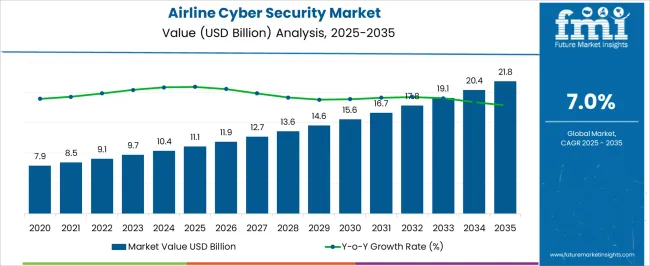
| Metric | Value |
|---|---|
| Airline Cyber Security Market Estimated Value in (2025 E) | USD 11.1 billion |
| Airline Cyber Security Market Forecast Value in (2035 F) | USD 21.8 billion |
| Forecast CAGR (2025 to 2035) | 7.0% |
The airline cyber security market is expanding rapidly due to the increasing reliance on digital systems in aviation operations and the growing sophistication of cyber threats targeting the sector. Airlines have adopted advanced security solutions to protect critical data, maintain safe flight operations, and ensure passenger privacy.
With more airlines shifting their IT infrastructure to cloud environments, demand for cloud-based cyber security solutions has surged to provide scalable and flexible protection. Regulatory bodies are mandating stringent cyber security standards, which further drives market adoption.
Additionally, network security remains a critical focus area as airlines seek to safeguard communication channels and operational networks from unauthorized access and attacks. As cyber threats evolve, the airline industry continues to invest heavily in robust security frameworks to mitigate risks and ensure operational continuity. Segment growth is expected to be led by Solutions as the primary component, Cloud deployment models, and Network Security as the dominant security type.
The airline cyber security market is segmented by component, deployment model, security type, end use, and region.
By Component: The market is divided into solutions and services.
By Deployment Model: The market is classified into cloud and on-premises.
By Security Type: The segmentation includes network security, cloud security, application security, and others.
By End Use: The market is divided into commercial airlines and private airlines.
By Region: Regionally, the airline cyber security market is categorized into North America, Latin America, Western Europe, Eastern Europe, Balkan & Baltic Countries, Russia & Belarus, Central Asia, East Asia, South Asia & Pacific, and the Middle East & Africa.
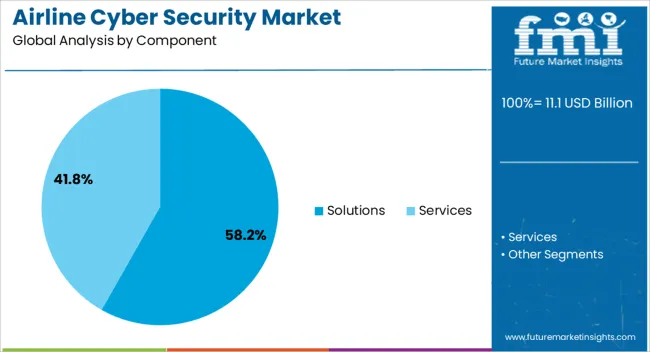
The Solutions segment is projected to account for 58.2% of the airline cyber security market revenue in 2025, maintaining its position as the largest component category. The growth of this segment is driven by airlines' need for comprehensive security platforms that include threat detection, vulnerability management, and incident response capabilities.
Solutions that integrate multiple security functions provide better visibility and faster response times to cyber incidents. The increasing complexity of airline IT environments and the need to protect diverse digital assets have heightened the demand for customizable and scalable security solutions.
Moreover, airlines are focusing on proactive defense mechanisms, pushing the adoption of advanced security solutions that incorporate artificial intelligence and machine learning. This trend is expected to continue fueling growth in the Solutions segment as airlines strengthen their cyber defenses.

The Cloud deployment model segment is expected to contribute 54.6% of the market revenue in 2025, positioning it as the preferred deployment option. Airlines are increasingly migrating to cloud platforms due to their flexibility, cost-effectiveness, and ability to support remote operations and data accessibility.
Cloud-based cyber security solutions offer scalable resources that can adapt to fluctuating demand and evolving threat landscapes. Additionally, cloud deployments enable centralized management and faster updates, critical for responding to emerging cyber threats in real time.
The growing adoption of digital services such as mobile apps, online booking, and in-flight connectivity has accelerated the need for secure cloud environments. As cloud technology matures and regulatory frameworks adapt, its prominence in airline cyber security is expected to grow further.
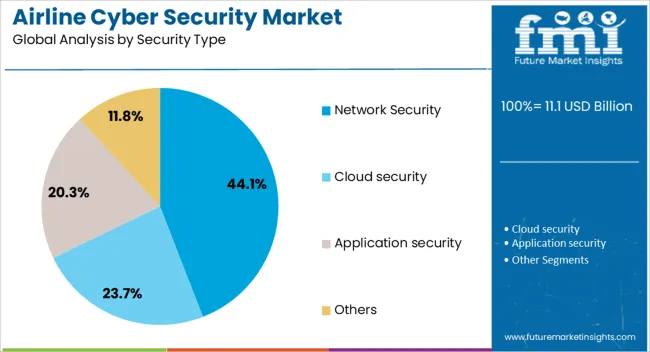
The Network Security segment is forecasted to hold 44.1% of the airline cyber security market revenue in 2025, remaining the most significant security type. Network security focuses on protecting the data communication channels within airline operations including ground control systems, onboard networks, and passenger services.
With increasing connectivity between aircraft and ground systems, safeguarding these networks is vital to prevent unauthorized access and data breaches. Airlines have prioritized implementing firewalls, intrusion detection systems, and encryption protocols to secure their network infrastructure.
The proliferation of IoT devices and connected systems in aviation has further underscored the need for strong network security measures. As cyberattacks targeting network vulnerabilities grow in sophistication, investment in this security type is expected to stay at the forefront of airline cyber security strategies.
The market has been expanding due to the growing reliance on digital systems for airline operations, passenger management, and fleet connectivity. Threats from malware, ransomware, and system intrusions have prompted airlines to adopt comprehensive cyber security solutions. Market growth has been supported by the implementation of advanced threat detection, network monitoring, and secure communication systems.
Increasing cyber incidents, regulatory compliance requirements, and the rise of connected aircraft and digital booking platforms have further strengthened the adoption of cyber security solutions in the airline industry globally.
The rapid adoption of digital technologies in airline operations has been a key driver of the airline cyber security market. Passenger reservation systems, ticketing platforms, operational control systems, and aircraft connectivity networks have been increasingly integrated with digital infrastructure, creating potential vulnerabilities. Airlines have been compelled to deploy advanced cyber security measures to prevent unauthorized access, data breaches, and operational disruptions. Multi-layered security frameworks, real-time threat monitoring, and endpoint protection systems have been implemented to safeguard sensitive operational and passenger data. Additionally, the integration of Internet of Things (IoT) devices, connected in-flight entertainment, and aircraft communication systems has further increased exposure to cyber threats. As airlines expand digital services and fleet connectivity, the demand for robust cyber security solutions has grown, ensuring operational reliability and passenger trust.
Technological innovation has strengthened the capabilities of airline cyber security systems, enabling proactive threat prevention and rapid incident response. AI-driven analytics, machine learning algorithms, and behavioral monitoring have been employed to detect anomalies and mitigate cyber risks. Cloud-based security platforms, intrusion detection systems, and secure data encryption have improved protection for both ground and in-flight operations. Automated vulnerability assessment tools and predictive threat modeling have enhanced the resilience of IT and OT networks. Additionally, continuous updates and patch management systems have ensured compliance with evolving security standards. These technological advancements have allowed airlines to maintain business continuity, protect passenger information, and minimize financial and reputational risks from cyber incidents.
Compliance with international aviation regulations and data protection standards has been a major factor driving the adoption of airline cyber security solutions. Airlines have been required to adhere to standards such as the International Civil Aviation Organization (ICAO) guidance, General Data Protection Regulation (GDPR), and regional aviation cyber security frameworks. Security policies, regular audits, and compliance reporting have been integrated into operational protocols to prevent regulatory penalties and ensure passenger safety. Automated monitoring of access controls, network segmentation, and data encryption have supported adherence to these standards. Increasing enforcement of cyber security regulations, coupled with growing concerns about passenger data privacy, has prompted airlines to strengthen their cyber defenses, making regulatory compliance a critical component of cyber security adoption strategies globally.
The rise of connected aircraft, in-flight internet services, and IoT integration has created significant growth opportunities in the airline cyber security market. Advanced avionics, predictive maintenance systems, and real-time data analytics platforms require secure communication channels and robust threat management. Airlines have increasingly implemented multi-layered security protocols to protect aircraft systems, operational networks, and passenger interfaces. The deployment of cloud platforms and integrated airline IT systems has increased demand for end-to-end cyber security solutions. Furthermore, the expansion of smart airports and digital passenger services, including mobile check-in and biometric authentication, has highlighted the need for comprehensive threat protection. These technological trends and connected operations are expected to drive the adoption of advanced airline cyber security solutions globally.
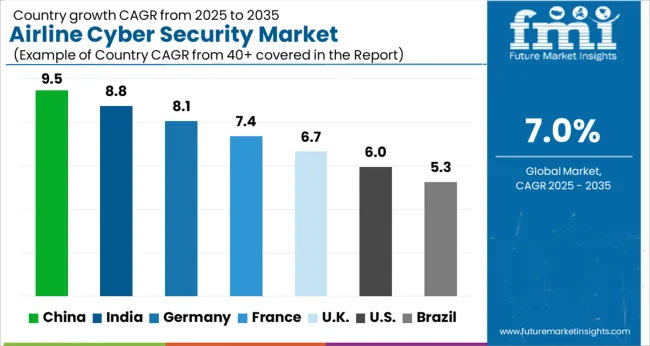
The market is projected to grow at a CAGR of 7.0% between 2025 and 2035, driven by increasing cyber threats in aviation, adoption of advanced threat detection systems, and regulatory compliance for data protection. China leads with a 9.5% CAGR, supported by investments in secure aviation networks and digital infrastructure. India follows at 8.8%, with growth fueled by modernization of airline operations and enhanced IT security protocols. Germany, at 8.1%, benefits from stringent data protection regulations and integration of cybersecurity solutions. The UK, growing at 6.7%, focuses on aviation IT risk mitigation, while the USA, at 6.0%, experiences steady demand linked to cybersecurity requirements across commercial and private airlines. This report includes insights on 40+ countries; the top markets are shown here for reference.
The airline cyber security industry in China is expected to grow at a CAGR of 9.5% from 2025 to 2035, propelled by the increasing digitization of airline operations and expanding air traffic volumes. National carriers are investing in next-generation threat detection and secure communication networks to protect passenger data and flight operations. Government directives on critical infrastructure protection are accelerating adoption of intrusion prevention and endpoint security solutions. Strategic collaborations with domestic technology providers are enhancing real-time threat monitoring. Focus on cloud-based security and AI-driven anomaly detection is increasing efficiency and reducing cyber risks.
India is forecast to expand at a CAGR of 8.8%, driven by the growth of commercial aviation and digital booking platforms. Airlines are implementing comprehensive cybersecurity solutions to protect against ransomware, phishing, and operational disruptions. Partnerships with technology vendors for AI-powered monitoring and real-time incident response are accelerating adoption. Federal guidelines on data privacy and infrastructure security are strengthening regulatory compliance. Continuous training and threat simulation programs are enhancing operational resilience.

Sales of airline cyber security solutions in Germany are anticipated to grow at a CAGR of 8.1% due to increasing reliance on automated flight systems and integrated airport operations. Major carriers are focusing on multi-layered security protocols, including endpoint protection, network segmentation, and anomaly detection. Collaboration with European cybersecurity firms is expanding to address cross-border data threats. Government-backed aviation security audits are ensuring compliance and promoting adoption. Investments in advanced threat intelligence platforms are being prioritized to safeguard critical operations.
The United Kingdom is projected to grow at a CAGR of 6.7%, supported by increased cyber threats targeting airline IT infrastructure and passenger services. Airlines are adopting AI-driven threat detection, secure cloud storage, and continuous risk assessment protocols. Government initiatives for aviation cybersecurity are promoting standardized practices across airports and carriers. Real-time monitoring of operational technology systems is becoming a critical focus. Collaboration with technology providers and academic institutions is facilitating innovation in predictive threat intelligence.
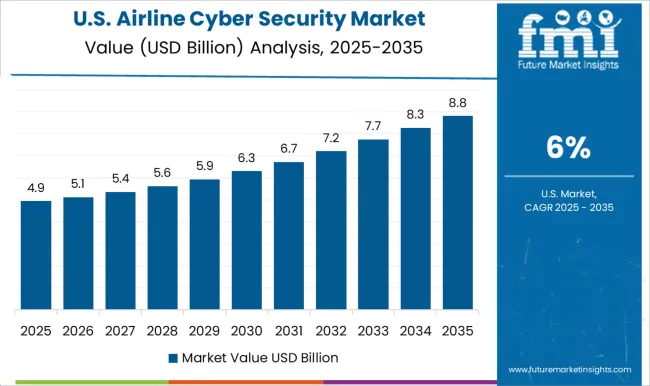
The United States market is expected to grow at a CAGR of 6.0%, driven by modernization of airline IT systems and cloud-based operational platforms. Airlines are investing in intrusion prevention, secure communications, and advanced analytics for real-time threat mitigation. Federal cybersecurity directives for aviation operators are enhancing compliance and promoting faster adoption of innovative solutions. Collaboration with major tech vendors is supporting deployment of scalable and low-latency security solutions. Emphasis on training programs and simulation exercises is strengthening operational readiness against emerging cyber threats.
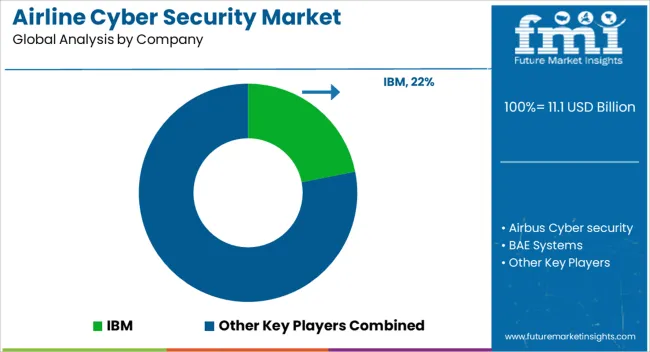
BAE Systems integrates advanced analytics and monitoring to safeguard airlines against sophisticated cyber-attacks targeting both data and critical operations. Cisco provides network-centric security solutions, ensuring robust defense across airline IT infrastructure and connected aircraft systems. Honeywell International develops aviation-focused cybersecurity tools, including real-time threat detection and secure communication protocols for cockpit and operational technology.
Symantec Corporation, now part of Broadcom, offers endpoint, cloud, and data protection services tailored to airlines, while Thales Group emphasizes encryption, secure access management, and compliance solutions for passenger and operational systems. Entry barriers are defined by specialized technical expertise, stringent regulatory requirements, and the need for continuous threat monitoring in high-stakes aviation environments.
| Item | Value |
|---|---|
| Quantitative Units | USD Billion |
| Component | Solutions and Services |
| Deployment Model | Cloud and On-premises |
| Security Type | Network Security, Cloud security, Application security, and Others |
| End Use | Commercial Airlines and Private Airlines |
| Regions Covered | North America, Europe, Asia-Pacific, Latin America, Middle East & Africa |
| Country Covered | United States, Canada, Germany, France, United Kingdom, China, Japan, India, Brazil, South Africa |
| Key Companies Profiled | IBM, Airbus Cyber security, BAE Systems, Cisco, Honeywell International, Symantec Corporation (now part of Broadcom), and Thales Group |
| Additional Attributes | Dollar sales by solution type and deployment model, demand dynamics across commercial airlines, cargo carriers, and regional operators, regional trends in adoption across North America, Europe, and Asia-Pacific, innovation in AI-driven threat detection, real-time network monitoring, and blockchain-based security frameworks, environmental impact of energy consumption in cybersecurity infrastructure, and emerging use cases in in-flight connectivity protection, aircraft system integrity, and passenger data privacy compliance. |
The global airline cyber security market is estimated to be valued at USD 11.1 billion in 2025.
The market size for the airline cyber security market is projected to reach USD 21.8 billion by 2035.
The airline cyber security market is expected to grow at a 7.0% CAGR between 2025 and 2035.
The key product types in airline cyber security market are solutions, _threat intelligence and response, _identity and access management, _data loss prevention, _risk and compliance management, _others, services, _consulting, _support and _integration.
In terms of deployment model, cloud segment to command 54.6% share in the airline cyber security market in 2025.






Full Research Suite comprises of:
Market outlook & trends analysis
Interviews & case studies
Strategic recommendations
Vendor profiles & capabilities analysis
5-year forecasts
8 regions and 60+ country-level data splits
Market segment data splits
12 months of continuous data updates
DELIVERED AS:
PDF EXCEL ONLINE
Airline Technology Integration Market Size and Share Forecast Outlook 2025 to 2035
Airline Crisis Management Software Market Size and Share Forecast Outlook 2025 to 2035
Airline Reservation Software Market Size and Share Forecast Outlook 2025 to 2035
Airline A-la-carte Services Market Analysis by Product Type, Carrier Type and Region from 2025 to 2035
Online Airline Booking Platform Market Size and Share Forecast Outlook 2025 to 2035
Cyber-Physical System Market Size and Share Forecast Outlook 2025 to 2035
Cyber Crisis Management Market by Type, Application, Vertical, and Region-Forecast through 2035
Cybersecurity Insurance Market - Trends & Forecast through 2034
Cyber Security in Robotics Market Size and Share Forecast Outlook 2025 to 2035
Drone Cybersecurity Market Size and Share Forecast Outlook 2025 to 2035
Maritime Cybersecurity Market Size and Share Forecast Outlook 2025 to 2035
Military Cyber Security Market Size and Share Forecast Outlook 2025 to 2035
Industrial Cybersecurity Market Size and Share Forecast Outlook 2025 to 2035
Automotive Cybersecurity Market Size and Share Forecast Outlook 2025 to 2035
Automotive Cyber Security Market Size and Share Forecast Outlook 2025 to 2035
Aerospace and Defense Cyber Security Market Size and Share Forecast Outlook 2025 to 2035
Artificial Intelligence In Cybersecurity Market Size and Share Forecast Outlook 2025 to 2035
Vehicle-to-Everything (V2X) Cybersecurity Market Size and Share Forecast Outlook 2025 to 2035
Security Holograms Market Size and Share Forecast Outlook 2025 to 2035
Security Paper Market Size and Share Forecast Outlook 2025 to 2035

Thank you!
You will receive an email from our Business Development Manager. Please be sure to check your SPAM/JUNK folder too.
Chat With
MaRIA